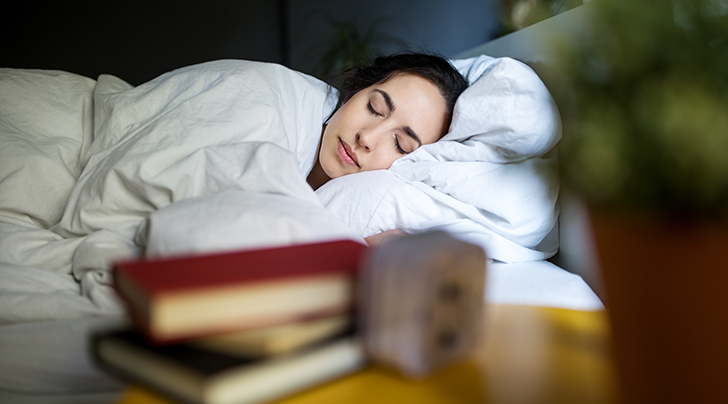How Sophrology Can Help You Get a Better Night’s Sleep

You’ve had a stressful day. (OK, let’s face it. You’ve had a stressful month.) But even though you’re exhausted and can’t wait to get under the covers, as soon as your head hits the pillow, you toss and turn, replaying that awkward thing you said at your friend’s birthday party three years ago. (Why, brain, why?)
The solution? Nope, not Ambien. It’s sophrology, a physical and mental exercise method that was developed by Spanish neuropsychiatrist Alfonso Caycedo in 1960. He combined philosophies from Japan, India, Tibet and Spain to create a comprehensive technique comprised of breathing practices, mindfulness, visualization, guided meditation and gentle movement. Today, it’s used among athletes, artists, people with anxiety and depression, and anyone looking to improve their performance. (Sleep guru Arianna Huffington is a fan, too.)
Florence Parot, author of The Sophrology Method, comes to the rescue with quick and easy sophrology tips to help you get a better night’s sleep.
RELATED: We Asked 5 People to Try Som, a Buzzy New Sleep Drink. Here’s the Verdict
1. Stop Thinking of Sleep as Unproductive
We get it. You’re busy and you pride yourself on the amount of stuff you can get done during the day. But it’s time to stop thinking about sleep as a waste of time and remember that it’s one of the most beneficial, healing things you can do for yourself. “Sleeping replenishes your energy, restores and repairs muscles and bones, boosts your immune system and renews your body,” Parot says. “You could say sleep makes you more intelligent.” So instead of looking at sleep as a necessary evil, think of it as an imperative part of your routine and a key to your success.
2. Set the Scene for Sleep
You’ve heard that watching TV and scrolling through Instagram before bed can interfere with your sleep (curse you, blue light). But sophrology takes it one step further. “Avoid light and noise in the bedroom,” Parot advises. “Even the smallest standby light or the fluorescent numbers on your alarm clock can halt the production of the sleep hormone melatonin.” And yep, that means TVs and cell phones should be banished from the bedroom, too. Do an audit of your room to make sure everything is as dark and quiet as possible before hitting the hay.
3. Visualize a Restful Sleep
Getting good sleep at night requires some preparation during the day. Duck into a conference room or quiet corner for 15 minutes—first, do a quick body scan (for the uninitiated, it’s a guided meditation practice that involves sitting quietly, staying aware of your breath and mindfully softening each part of the body, from head to toe). Next, focus on your breathing for a minute. Now, visualize yourself going to bed tonight. Imagine everything going exactly as you want it to. Envision your ideal, relaxing evening, and imagine yourself drifting off to sleep quickly and easily. Associate a word that symbolizes this restful sleep to you (we love the word “release”), then as you breathe in, imagine you are breathing in that word. Picture yourself waking up feeling energized and at your very best. Take a few more minutes to sit in the room and observe how you’re feeling before heading to your next meeting.
4. Practice Square Breathing
It’s 2 a.m. and you’re still awake. Don’t panic—instead, try some square breathing. Breathe in, counting to three, then hold the air in your lungs for a count of three, breathe out for a count of three and then hold with your lungs empty for a count of three. (It’s four-sided breathing, like a square.) If counting to three isn’t comfortable or restful for you, try a slower or faster count. Repeat for a couple of minutes, then begin to breathe naturally again and take note of how you’re feeling. By making each breath even in length and inserting small pauses in between, Parot maintains that we are giving our breathing stability—and that stability will begin to transfer to the whole self. (Plus, we dare you to worry about that big project you have due at the end of the week when you’re concentrating on breathing in a square.)
5. Try a Flash Nap
We know what you’re thinking. I don’t have time to eat lunch, let alone take an afternoon nap. Same. That’s why we’re obsessed with the flash nap, a lightning fast nap that was popularized by Salvador Dalí. . Sit down on a chair with your arms at your sides and hold a key in one hand. Relax and take deep breaths—as you begin to drift off, you’ll drop the key on the floor, snapping you out of the nap. That’s it! Believe it or not, this extremely brief rest can provide a reset for your body and mind (just make sure you’re not in a room with a heavily carpeted floor, or the sound of the key dropping won’t wake you up).
RELATED: Sweet Dreams and Caffeine: Science Says You Should Be Taking Coffee Naps

